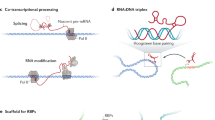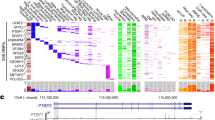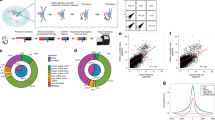Abstract
Genome-wide occupancy profiles of five components of the RNA polymerase III (Pol III) machinery in human cells identified the expected tRNA and noncoding RNA targets and revealed many additional Pol III–associated loci, mostly near short interspersed elements (SINEs). Several genes are targets of an alternative transcription factor IIIB (TFIIIB) containing Brf2 instead of Brf1 and have extremely low levels of TFIIIC. Strikingly, expressed Pol III genes, unlike nonexpressed Pol III genes, are situated in regions with a pattern of histone modifications associated with functional Pol II promoters. TFIIIC alone associates with numerous ETC loci, via the B box or a novel motif. ETCs are often near CTCF binding sites, suggesting a potential role in chromosome organization. Our results suggest that human Pol III complexes associate preferentially with regions near functional Pol II promoters and that TFIIIC-mediated recruitment of TFIIIB is regulated in a locus-specific manner.
This is a preview of subscription content, access via your institution
Access options
Subscribe to this journal
Receive 12 print issues and online access
$189.00 per year
only $15.75 per issue
Buy this article
- Purchase on Springer Link
- Instant access to full article PDF
Prices may be subject to local taxes which are calculated during checkout






Similar content being viewed by others
References
Dieci, G., Fiorino, G., Castelnuovo, M., Teichmann, M. & Pagano, A. The expanding RNA polymerase III transcriptome. Trends Genet. 23, 614–622 (2007).
Geiduschek, E.P. & Kassavetis, G.A. The RNA polymerase III transcription apparatus. J. Mol. Biol. 310, 1–26 (2001).
Schramm, L. & Hernandez, N. Recruitment of RNA polymerase III to its target promoters. Genes Dev. 16, 2593–2620 (2002).
Harismendy, O. et al. Genome-wide location of yeast RNA polymerase III transcription machinery. EMBO J. 22, 4738–4747 (2003).
Moqtaderi, Z. & Struhl, K. Genome-wide occupancy of the RNA polymerase III machinery in Saccharomyces cerevisiae reveals loci with incomplete transcription complexes. Mol. Cell. Biol. 24, 4118–4127 (2004).
Roberts, D.N., Stewart, A.J., Huff, J.T. & Cairns, B.R. The RNA polymerase III transcriptome revealed by genome-wide localization and activity-occupancy relationships. Proc. Natl. Acad. Sci. USA 100, 14695–14700 (2003).
Oficjalska-Pham, D. et al. General repression of RNA polymerase III transcription is triggered by protein phosphatase type 2A-mediated dephosphorylation of Maf1. Mol. Cell 22, 623–632 (2006).
Roberts, D.N., Wilson, B., Huff, J.T., Stewart, A.J. & Cairns, B.R. Dephosphorylation and genome-wide association of Maf1 with Pol III-transcribed genes during repression. Mol. Cell 22, 633–644 (2006).
Upadhya, R., Lee, J. & Willis, I.M. Maf1 is an essential mediator of diverse signals that repress RNA polymerase III transcription. Mol. Cell 10, 1489–1494 (2002).
Noma, K., Cam, H.P., Maraia, R.J. & Grewal, S.I. A role for TFIIIC transcription factor complex in genome organization. Cell 125, 859–872 (2006).
Kuras, L., Kosa, P., Mencia, M. & Struhl, K. TAF-containing and TAF-independent forms of transcriptionally active TBP in vivo. Science 288, 1244–1248 (2000).
Parrott, A.M. & Mathews, M.B. Novel rapidly evolving hominid RNAs bind nuclear factor 90 and display tissue-restricted distribution. Nucleic Acids Res. 35, 6249–6258 (2007).
Borchert, G.M., Lanier, W. & Davidson, B.L. RNA polymerase III transcribes human microRNAs. Nat. Struct. Mol. Biol. 13, 1097–1101 (2006).
Bortolin-Cavaille, M.-L., Dance, M., Weber, M. & Cavaille, J. C19MC microRNAs are processed from introns of large Pol-II, non-protein-coding transcripts. Nucleic Acids Res. 37, 3464–3473 (2009).
Lee, W. et al. A high-resolution atlas of nucleosome occupancy in yeast. Nat. Genet. 39, 1235–1244 (2007).
Mavrich, T.N. et al. A barrier nucleosome model for statistical positioning of nucleosome throughout the yeast genome. Genome Res. 18, 1073–1083 (2008).
Raha, D. et al. Close association of RNA polymerase II and many transcription factors with Pol III genes. Proc. Natl. Acad. Sci. USA (in the press), 107 (2010).
Carbon, P. & Krol, A. Transcription of the Xenopus laevis selenocysteine tRNA(Ser)Sec gene: a system that combines an internal B box and upstream elements also found in U6 snRNA genes. EMBO J. 10, 599–606 (1991).
D'Ambrosio, C. et al. Identification of cis-acting sites for condensin loading onto budding yeast chromosomes. Genes Dev. 22, 2215–2227 (2008).
Haeusler, R.A., Pratt-Hyatt, M., Good, P.D., Gipson, T.A. & Engelke, D.R. Clustering of yeast tRNA genes is mediated by specific association of condensin with tRNA gene transcription complexes. Genes Dev. 22, 2204–2214 (2008).
Simms, T.A. et al. TFIIIC binding sites function as both heterochromatin barriers and chromatin insulators in Saccharomyces cerevisiae. Eukaryot. Cell 7, 2078–2086 (2008).
Valenzuela, L., Dhillon, N. & Kamakaka, R.T. Transcription independent insulation at TFIIIC-dependent insulators. Genetics 183, 131–148 (2009).
Donze, D., Adams, C.R., Rine, J. & Kamakaka, R.T. The boundaries of the silenced HMR domain in Saccharomyces cerevisiae. Genes Dev. 13, 698–708 (1999).
Wallace, J.A. & Felsenfeld, G. We gather together: insulators and genome organization. Curr. Opin. Genet. Dev. 17, 400–407 (2007).
Parelho, V. et al. Cohesins functionally associate with CTCF on mammalian chromosome arms. Cell 132, 422–433 (2008).
Core, L.J. & Lis, J.T. Transcription regulation through promoter-proximal pausing of RNA polymerase. Science 319, 1791–1792 (2008).
Fuda, N.J., Ardehali, M.B. & Lis, J.T. Defining mechanisms that regulate RNA polymerase II transcription in vivo. Nature 461, 186–192 (2009).
Kenneth, N.S. et al. TRRAP and GCN5 are used by c-Myc to activate RNA polymerase III transcription. Proc. Natl. Acad. Sci. USA 104, 14917–14922 (2007).
Yuan, C.-C. CHD8 associates with human Staf and contributes to efficient U6 RNA polymerase III transcription. Mol. Cell. Biol. 27, 8729–8738 (2007).
Hsieh, Y.J., Kundu, T.K., Wang, Z., Kovelman, R. & Roeder, R.G. The TFIIIC90 subunit of TFIIIC interacts with multiple components of the RNA polymerase III machinery and contains a histone-specific acetyltransferase activity. Mol. Cell. Biol. 19, 7697–7704 (1999).
Kundu, T.K., Wang, Z. & Roeder, R.G. Human TFIIIC relieves chromatin-mediated repression of RNA polymerase III transcription and contains an intrinsic histone acetyltransferase activity. Mol. Cell. Biol. 19, 1605–1615 (1999).
Mertens, C. & Roeder, R.G. Different functional modes of p300 in activation of RNA polymerase transcription from chromatin templates. Mol. Cell. Biol. 28, 5764–5776 (2008).
Rollins, J., Veras, I., Cabarcas, S., Willis, I. & Schramm, L. Human Maf1 negatively regulates RNA polymerase III transcription via the TFIIB family members Brf1 and Brf2. Int. J. Biol. Sci. 3, 292–302 (2007).
Sutcliffe, J.E., Brown, T.R., Allison, S.J., Scott, P.H. & White, R.J. Retinoblastoma protein disrupts interactions required for RNA polymerase III transcription. Mol. Cell. Biol. 20, 9192–9202 (2000).
Crighton, D. et al. p53 represses RNA polymerase III transcription by targeting TBP and inhibiting promoter occupancy by TFIIIB. EMBO J. 22, 2810–2820 (2003).
Felton-Edkins, Z.A. et al. The mitogen-activated protein (MAP) kinase ERT induces tRNA synthesis by phosphorylating TFIIIB. EMBO J. 22, 2422–2432 (2003).
Hiraga, S., Botsios, S. & Donaldson, A.D. Histone H3 lysine 56 acetylation by Rtt1090 is crucial for nucleosome positioning. J. Cell Biol. 183, 641–651 (2008).
Miotto, B. & Struhl, K. HBO1 histone acetylase is a co-activator of the replication licensing factor Cdt1. Genes Dev. 22, 2633–2638 (2008).
Fairley, J.A., Scott, P.H. & White, R.J. TFIIIB is phosphorylated, disrupted and selectively released from tRNA promoters during mitosis in vivo. EMBO J. 22, 5841–5850 (2003).
Cairns, C.A. & White, R.J. p53 is a general repressor of RNA polymerase III transcription. EMBO J. 17, 3112–3123 (1998).
Zhang, Y. et al. Intrinsic histone-DNA interactions are not the major determinant of nucleosome positions in vivo. Nat. Struct. Mol. Biol. 16, 847–852 (2009).
Zhang, Y. et al. Model-based analysis of ChIP-Seq (MACS). Genome Biol. 9, R137 (2008).
Nicol et al. The Integrated Genome Browser: free software for distribution and exploration of genome-scale datasets. Bioinformatics 25, 2730–2731 (2009).
Karolchik, D. et al. The UCSC Genome Browser database. Nucleic Acids Res. 31, 51–54 (2003).
Chan, P.P. & Lowe, T.M. GtRNAdb: a database of transfer RNA genes detected in genomic sequence. Nucleic Acids Res. 37, D93–D97 (2009).
Bailey, T.L. & Elkan, C. Fitting a mixture model by expectation maximization to discover motifs in biopolymers. Proc. Int. Conf. Intell. Syst. Mol. Biol. 2, 28–36 (1994).
Acknowledgements
We thank T. Liu and X. Liu for initial comments about the sequencing data, J. Mellor for helpful advice on programming in Python, N. Lamarre-Vincent, X. Fan, H. Hirsch and M. Lindahl Allen for discussion, G. Euskirchen, H. Monahan, M. Shi and P. Lacroute for help with DNA sequencing and M. Wilson for help with database submission. Funding for this work was provided by US National Institutes of Health grants GM 30186 (K.S.), HG 4558 (M.S. and K.S.) and HG 4695 (Z.W.).
Author information
Authors and Affiliations
Contributions
Z.M. designed the experiments, performed and analyzed the ChIP and validation experiments, performed bioinformatics analysis, constructed figures and wrote the paper; J.W. performed bioinformatics analysis, discussed the results and constructed figures; D.R. supervised the library construction and Illumina sequencing of the immunoprecipitated DNA; R.J.W. provided the antibodies used in the ChIPs, discussed the results and suggested modifications to the text; M.S. supervised the library construction and Illumina sequencing of the immunoprecipitated DNA; Z.W. supervised the bioinformatics analysis and participated in substantial discussion of the bioinformatics and figures; K.S. participated in substantial discussion of all experiments, results and figures and contributed to the text.
Corresponding author
Ethics declarations
Competing interests
The authors declare no competing financial interests.
Supplementary information
Supplementary Text and Figures
Supplementary Figure 1 (PDF 193 kb)
Supplementary Data 1
Peak lists obtained by MACS analysis of each ChIP sequencing data set (XLS 1033 kb)
Supplementary Data 2
Rpc155 targets with gene annotations. (XLS 557 kb)
Supplementary Data 3
List of ETC loci as defined by a TFIIIC-110/Rpc155 ratio greater than three standard deviations above the median ratio at tRNA genes. (XLS 973 kb)
Rights and permissions
About this article
Cite this article
Moqtaderi, Z., Wang, J., Raha, D. et al. Genomic binding profiles of functionally distinct RNA polymerase III transcription complexes in human cells. Nat Struct Mol Biol 17, 635–640 (2010). https://doi.org/10.1038/nsmb.1794
Received:
Accepted:
Published:
Issue Date:
DOI: https://doi.org/10.1038/nsmb.1794
This article is cited by
-
Selective gene expression maintains human tRNA anticodon pools during differentiation
Nature Cell Biology (2024)
-
Chromatin remodeling by Pol II primes efficient Pol III transcription
Nature Communications (2023)
-
A cancer-associated RNA polymerase III identity drives robust transcription and expression of snaR-A noncoding RNA
Nature Communications (2022)
-
Manipulation of RNA polymerase III by Herpes Simplex Virus-1
Nature Communications (2022)
-
Regulatory networking of the three RNA polymerases helps the eukaryotic cells cope with environmental stress
Current Genetics (2021)



